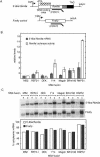Splicing enhances translation in mammalian cells: an additional function of the exon junction complex
- PMID: 14752011
- PMCID: PMC324426
- DOI: 10.1101/gad.1163204
Splicing enhances translation in mammalian cells: an additional function of the exon junction complex
Abstract
In mammalian cells, spliced mRNAs yield greater quantities of protein per mRNA molecule than do otherwise identical mRNAs not made by splicing. This increased translational yield correlates with enhanced cytoplasmic polysome association of spliced mRNAs, and is attributable to deposition of exon junction complexes (EJCs). Translational stimulation can be replicated by tethering the EJC proteins Y14, Magoh, and RNPS1 or the nonsense-mediated decay (NMD) factors Upf1, Upf2, and Upf3b to an intronless reporter mRNA. Thus, in addition to its previously characterized role in NMD, the EJC also promotes mRNA polysome association. Furthermore, the ability to stimulate translation when bound inside an open reading frame appears to be a general feature of factors required for NMD.
Figures





Similar articles
-
Exon-junction complex components specify distinct routes of nonsense-mediated mRNA decay with differential cofactor requirements.Mol Cell. 2005 Oct 7;20(1):65-75. doi: 10.1016/j.molcel.2005.08.012. Mol Cell. 2005. PMID: 16209946
-
Trypanosomes lack a canonical EJC but possess an UPF1 dependent NMD-like pathway.PLoS One. 2025 Mar 7;20(3):e0315659. doi: 10.1371/journal.pone.0315659. eCollection 2025. PLoS One. 2025. PMID: 40053537 Free PMC article.
-
Binding of a novel SMG-1-Upf1-eRF1-eRF3 complex (SURF) to the exon junction complex triggers Upf1 phosphorylation and nonsense-mediated mRNA decay.Genes Dev. 2006 Feb 1;20(3):355-67. doi: 10.1101/gad.1389006. Genes Dev. 2006. PMID: 16452507 Free PMC article.
-
New insights into the formation of active nonsense-mediated decay complexes.Trends Biochem Sci. 2003 Sep;28(9):464-6. doi: 10.1016/S0968-0004(03)00176-2. Trends Biochem Sci. 2003. PMID: 13678954 Review.
-
A new function for nonsense-mediated mRNA-decay factors.Trends Genet. 2005 Mar;21(3):143-8. doi: 10.1016/j.tig.2005.01.007. Trends Genet. 2005. PMID: 15734573 Review.
Cited by
-
Perispeckles are major assembly sites for the exon junction core complex.Mol Biol Cell. 2012 May;23(9):1765-82. doi: 10.1091/mbc.E12-01-0040. Epub 2012 Mar 14. Mol Biol Cell. 2012. PMID: 22419818 Free PMC article.
-
The leader intron of AtMHX can elicit, in the absence of splicing, low-level intron-mediated enhancement that depends on the internal intron sequence.BMC Plant Biol. 2010 May 20;10:93. doi: 10.1186/1471-2229-10-93. BMC Plant Biol. 2010. PMID: 20487561 Free PMC article.
-
Innate, translation-dependent silencing of an invasive transposon in Arabidopsis.EMBO Rep. 2022 Feb 3;23(3):e53400. doi: 10.15252/embr.202153400. Epub 2021 Dec 21. EMBO Rep. 2022. PMID: 34931432 Free PMC article.
-
The coming-of-age of nucleocytoplasmic transport in motor neuron disease and neurodegeneration.Cell Mol Life Sci. 2019 Jun;76(12):2247-2273. doi: 10.1007/s00018-019-03029-0. Epub 2019 Feb 11. Cell Mol Life Sci. 2019. PMID: 30742233 Free PMC article. Review.
-
NMD: At the crossroads between translation termination and ribosome recycling.Biochimie. 2015 Jul;114:2-9. doi: 10.1016/j.biochi.2014.10.027. Epub 2014 Nov 13. Biochimie. 2015. PMID: 25446649 Free PMC article. Review.
References
-
- Badolato J., Gardiner, E., Morrison, N., and Eisman, J. 1995. Identification and characterization of a novel human RNA-binding protein. Gene 166: 323-327. - PubMed
-
- Bouvet P. and Wolffe, A.P. 1994. A role for transcription and FRGY2 in masking maternal mRNA within Xenopus oocytes. Cell 77: 931-941. - PubMed
Publication types
MeSH terms
Substances
Grants and funding
LinkOut - more resources
Full Text Sources
Other Literature Sources
Molecular Biology Databases
